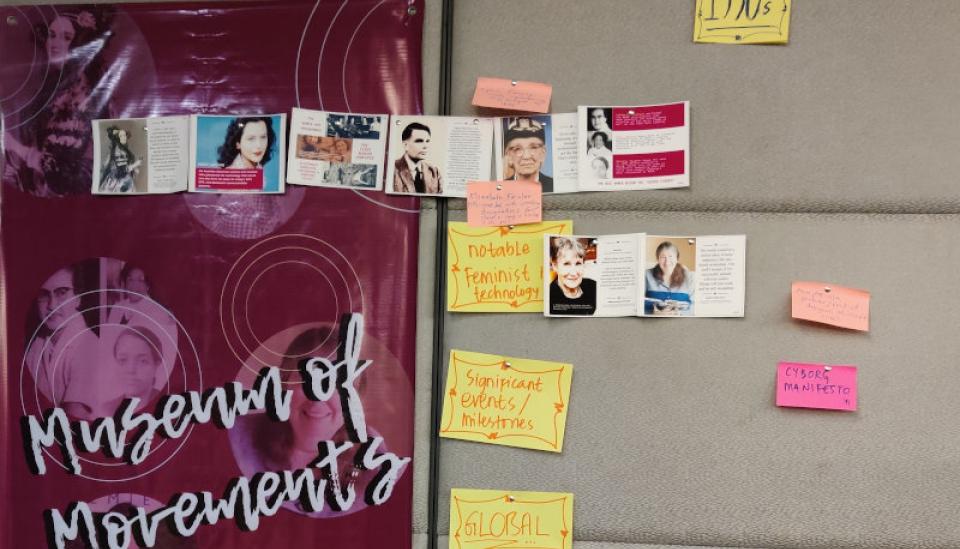Principles in action! Stories as pathways
 Museum of movements, by Shivani Lal (cropped). Creative Commons BY-SA(link is external).
Museum of movements, by Shivani Lal (cropped). Creative Commons BY-SA(link is external).
The act of sharing stories and recalling past moments of pleasure, power or significance in our activism and personal lives render our role in shaping the internet and the world visible, to one another, and to ourselves. Below are five activities that can help you and the participants of your conversation get to know one another!
First times!
Ask participants, Think back to the first time you found pleasure online! When was it? What device were you using? On what platform did you find pleasure, and with what activity? Describe the scenario, the feeling, the sense of discovery!
-
Participants will come up with as many experiences as there are participants themselves, with some experiences dating back to childhood memories of online gaming to other experiences featuring secret searches for online porn.
-
Encourage as many responses to emerge in the wider group as possible.
-
As similarities start to emerge between responses, ask participants to find others in the room who had similar first time encounters to them.
-
As groups come together, give the small groups five minutes to talk about their experiences amongst each other.
|
Resources you may need for this activity
|
Internet loves!
Ask participants, What is one thing that you absolutely love about the internet? This question prompts participants to remember how beneficial the internet is and has been – personally, professionally, in movement building and for networking. This is an especially good question to ask when participants are coming into the conversation with a lot of negative sentiments about the internet.
-
Invite participants to stand in a circle and share one thing they love about the internet. It could relate to them personally, their activism, or something more general.
-
Each participant gets a turn to speak as responses are shared around the circle, with a rule that nobody can repeat what another person has said previously.
-
Encourage short interventions! One way to ensure no participant takes too much time is for a box of matches to be sent around the circle, and for each participant to light a match and finish their response before it burns down.
|
Resources you may need for this activity
|
First transgressions!
Ask participants to think back to the first time they searched for something ‘taboo’ online! What was it?
-
Get participants to stand together in the room.
-
Diverse responses will emerge on anything from transition surgery to periods, from understanding feminism to confronting religion.
-
Invite participants to give ‘popcorn’ responses, which will encourage quick and light-hearted responses.
-
As similarities emerge in the room, ask participants to find those with whom they share experiences
-
Give each smaller group five minutes to talk among one another about their first transgressions.
|
Resources you may need for this activity
|
Sex and the internet!
Ask participants, When was the first time you made the connection between sex and the internet? Was it a conversation with a friend? An online search? Downloading a dating app? Sexting with a distanced lover?
-
Invite voluntary responses from participants that describe their first time exploring sex or intimacy online.
-
Keep the activity flowing and light-hearted by asking participants to give quick interventions
| Time: approximately 10-15 mins |
Museum of movements!
When we reflect collectively on some of the memories we have of significant moments in our activism, we surface the bookmarks that tie common references together!
-
Invite participants to bring to the local conversation an artefact from their activism. This is a material item that can include anything from a flyer, a sticker, a T-shirt, photographs or protest banners!
-
Once you are ready to start the activity, bring participants together in the room, either seated or standing in a circle so that each person can see the other clearly.
-
Go around the room and invite participants to share the story connected to their artefact. Ask participants, How did you become involved in that particular moment? Why did that moment matter to you? Who were the people around you in that moment that you loved, were inspired by, or with whom you were building relationships of care and solidarity? How did your presence and action in that moment rupture the normality of discrimination?
-
Keep watch of the time, and limit different inputs from participants according to the time constraint you have for this activity and the number of people participating.
-
If participants are many, split participants up into smaller groups for more intimate engagement and conversation.
|
Resources you may need for this activity
|
Note: This activity will require pre-planning, since it is helpful to ask participants well in advance to dig into their material history and bring an artefact from their activism to the conversation.

No Comments